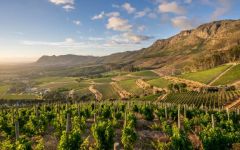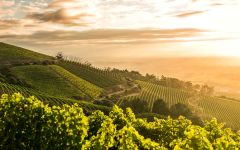Klein Constantia Vin de Constance (500ML) 2007
- Decanter
-
Wine
Spectator -
Wine &
Spirits



Product Details
Your Rating
Somm Note
Winemaker Notes
Professional Ratings
-
Decanter
Rounder, fruitier, with that blade of acidity clothed in flesh, with toffee and bitter marmalade notes, very aromatic and spicy. More new oak was being used by this date, but it’s perfectly integrated into the wine and just shows itself as slightly more weight at the centre. Huge finish.
-
Wine Spectator
Gorgeous, featuring a core of creamed peach, persimmon, maple and nectarine notes inlaid with flashes of green tea, dried papaya and mango. Lush and refined, with accents of blood orange and mouthwatering spice echoing on the finish. Muscat de Frontignan.
-
Wine & Spirits
Napoleon Bonaparte purportedly guzzled 30 bottles of Vin de Constance a month. If those vintages were anything like this 2007, it's easy to see why. Made from muscat de Frontignan planted at the original 1650s site, the grapes left to raisin on the vine, this feels ethereal. It's impressively delicate for its succulent texture, maintaining focused freshness in spring-like floral notes, while coating the palate in warmer flavors of apricot, tamarind, candied orange and exotic spice. The finish is bright and seemingly everlasting, mirroring the golden tone that emanates from the glass.
Other Vintages
2018-
James
Suckling -
Robert
Parker
- Decanter
-
James
Suckling -
Robert
Parker
-
James
Suckling - Decanter
- Vinous
-
Wine
Spectator
- Decanter
-
Robert
Parker - Vinous
-
Wine
Spectator
-
Robert
Parker -
James
Suckling -
Wine
Spectator
-
James
Suckling -
Wine
Spectator -
Robert
Parker
-
Wine
Spectator -
Robert
Parker
-
Wine
Spectator -
Robert
Parker
- Decanter
-
Robert
Parker
-
Wine
Enthusiast -
Wine
Spectator
-
Robert
Parker -
Wine
Spectator







Described as one of the world’s most beautiful vineyards, Klein Constantia is set amidst ancient trees and lush greenery on the upper foothills of the Constantiaberg, with superb views across the Constantia Valley and False Bay.
The HECTARE WINE ESTATE originally formed part of "Constantia", a vast property established in 1685 by Simon van der Stel, the first governor of the Cape. This particular valley was chosen not only for its beauty, but also for the decomposed granite soils on its slopes, gently cooled by ocean breezes.
Prized by leaders and aristocracy throughout 18th Century Europe, Constantia’s Vin de Constance was revived by Klein Constantia in 1986, reaffirming this unique natural sweet wine’s place in history.
Today, Klein Constantia continues to make some of South Africa’s top wines and the world’s best dessert wine; wines that reflect the cool Constantia climate, as well as their historic tradition.

Apart from the classics, we find many regional gems of different styles.
Late harvest wines are probably the easiest to understand. Grapes are picked so late that the sugars build up and residual sugar remains after the fermentation process. Ice wine, a style founded in Germany and there referred to as eiswein, is an extreme late harvest wine, produced from grapes frozen on the vine, and pressed while still frozen, resulting in a higher concentration of sugar. It is becoming a specialty of Canada as well, where it takes on the English name of ice wine.
Vin Santo, literally “holy wine,” is a Tuscan sweet wine made from drying the local white grapes Trebbiano Toscano and Malvasia in the winery and not pressing until somewhere between November and March.
Rutherglen is an historic wine region in northeast Victoria, Australia, famous for its fortified Topaque and Muscat with complex tawny characteristics.

With an important wine renaissance in full swing, impressive red and white bargains abound in South Africa. The country has a particularly long and rich history with winemaking, especially considering its status as part of the “New World.” In the mid-17th century, the lusciously sweet dessert wines of Constantia were highly prized by the European aristocracy. Since then, the South African wine industry has experienced some setbacks due to the phylloxera infestation of the late 1800s and political difficulties throughout the following century.
Today, however, South Africa is increasingly responsible for high-demand, high-quality wines—a blessing to put the country back on the international wine map. Wine production is mainly situated around Cape Town, where the climate is generally warm to hot. But the Benguela Current from Antarctica provides brisk ocean breezes necessary for steady ripening of grapes. Similarly, cooler, high-elevation vineyard sites throughout South Africa offer similar, favorable growing conditions.
South Africa’s wine zones are divided into region, then smaller districts and finally wards, but the country’s wine styles are differentiated more by grape variety than by region. Pinotage, a cross between Pinot Noir and Cinsault, is the country’s “signature” grape, responsible for red-fruit-driven, spicy, earthy reds. When Pinotage is blended with other red varieties, like Cabernet Sauvignon, Merlot, Syrah or Pinot Noir (all commonly vinified alone as well), it is often labeled as a “Cape Blend.” Chenin Blanc (locally known as “Steen”) dominates white wine production, with Chardonnay and Sauvignon Blanc following close behind.
